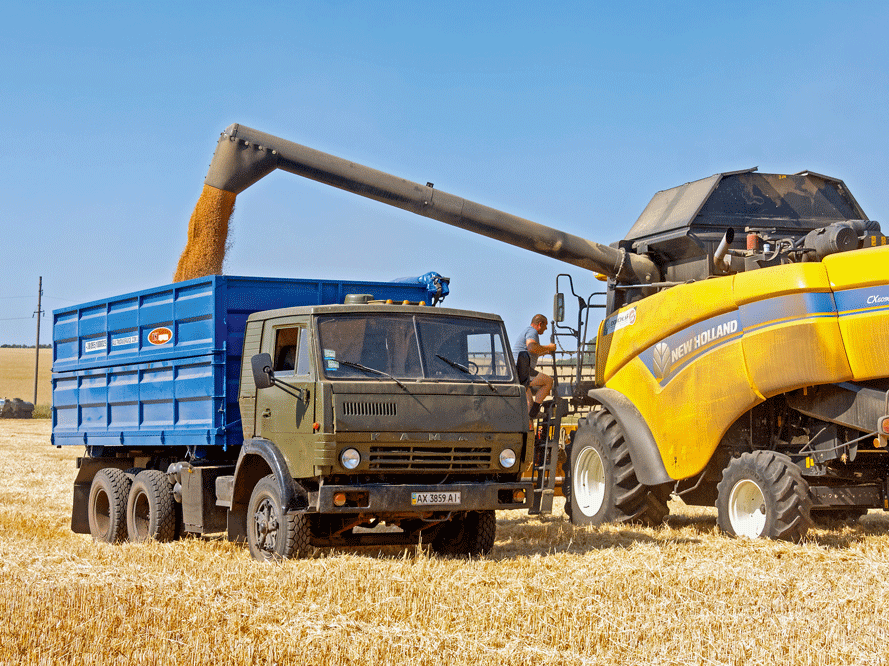Ukraine: The grain market remains flooded
By Dr Christian Bickert, DLG Mitteilungen
The quantities are enormous, much larger than most of us would ever have thought possible. Despite days of waiting at the borders, by 1 May more than 15 million tonnes of grain and oilseeds had already entered the EU by land, i.e. mainly to Poland, Romania, Slovakia, Hungary and Bulgaria. Some of it went on to Western Europe (mainly rapeseed, soya and maize), but most of the wheat remained on the market of the neighbouring countries.
At the same time, Ukraine supplies Spain and Italy with wheat and maize via the sea route, so that these two important import countries of the EU internal market are less receptive to goods north of the Alps. In total, from July 2022 to 1 May 2023, we are talking about 24.4 million tonnes of cereals and oilseeds imported by the EU from Ukraine. In the same period a year earlier, the figure was 9.5 million tonnes.
More Ukrainian grain now arrives " without buffer"
Since the beginning of May, Ukrainian grain has been banned from being imported into neighbouring EU countries and Bulgaria until 5 June. Transit to the West, on the other hand, remains permitted. This means that we now have to reckon with increasing direct deliveries. The bottom line is that this will not change much: Until now, Ukrainian grain displaced Polish grain, which was delivered to Germany in return. However, there was a buffer: the Polish colleagues did not sell and built up stocks. Now, shortly before the harvest, they are desperately looking for sales opportunities. Either they are in direct competition with German origins for export or they are shipped directly to Germany.
There are also large surpluses in Hungary. However, this has less to do with Ukrainian deliveries than with the right of first refusal on all grain deliveries, which the Hungarian state was able to exercise until 15 January. As a result, hardly any grain flowed out of Hungary. Prices were very high and even Austria (a net importer of maize) delivered maize to Hungary. There, the warehouses are still full and have to be cleared before the harvest in a few weeks. This also increases the pressure.
Oilseed prices also fall
Even before this war in Ukraine, oilseeds were entering the EU duty-free. Rapeseed deliveries from there almost doubled from 1.6 to 3 million tonnes - but this is not due to the war, but mainly to the excellent harvest in Ukraine. Deliveries from Australia also rose in the first ten months of this marketing year by 1 to 3 million tonnes. The additional imports of soybeans from the war-torn country (1.1 million tonnes instead of 0.4 million tonnes) are much larger, but this also means little for the local market: total EU imports fell from 11.8 to 10.3 million tonnes. Ukrainian soy has therefore at best replaced soy from the USA or South America.
This probably also applies to the 2 million tonnes of sunflower seed - a fourfold increase on the previous year. The additional sunflower meal is certainly also a reason for the decline in soya imports. The bottom line is that the war has had little impact on oilseed supplies. Rather, it is the combination of high prices at home and record harvests in Australia and Ukraine that led to the high imports.
What are the prospects for the grain market?
The EU continues to be the focus of Ukrainian grain exports. The poor EU maize harvest last year favoured this. Of the almost 21 million tonnes of maize exported by Ukraine since July, 12.8 million tonnes went to the EU - just under half of it by land - and permanently duty-free. A year earlier (with a good EU maize harvest), this was only 7 million tonnes in this period.
In the case of wheat, imports have even increased more than tenfold: 350,000 tonnes a year ago (with a tariff quota) have now become 4.8 million tonnes - and in the case of wheat the EU itself is one of the largest surplus countries in the world. 2.8 million tonnes of wheat came by sea, mainly to Italy, Spain and the Netherlands - and from there certainly also to German and Belgian feed mills.
What do the numbers say?
No one knows or can forecast how and when the war will end and the sea routes for Ukraine out of which ports will be free again. But new trade routes have formed. Would they be able to take in even larger quantities if the grain corridor were closed? We do not know. But the past year has shown: If the pressure is great enough, ways can be found.
In any case, after the end of the war, grain from the south will certainly not be transported to the EU, which is still a surplus area, by the expensive land route. These goods will go to the seaports, as before. But from western Ukraine and parts of the north, it is no further to Poland or Romania than to Odessa. In addition, new railway lines are being built for broad gauge or the transhipment capacities are being expanded. This means that pressure on the Eastern European domestic market can be expected in the coming years as well. One way or another, this pressure will continue westwards. It is impossible to estimate to what extent Spain, Italy and also Portugal will permanently serve Ukraine with open sea routes.
The outlook for the coming harvest is rather dark
For Ukraine the wheat harvest estimates are between 16 and 18 million tonnes, for Russia 82 to 86 million tonnes are in the forecast. Both figures are linked to very large uncertainties. In the south of Russia and in the Ukraine it rained well in April and also at the beginning of May, in the Ukraine often even too much. This temporarily hampered the sowing of sunflowers and maize, but is extremely beneficial for winter cereals and rapeseed. This means that slightly higher harvest results can be achieved. There are no reliable forecasts for maize so far. The only thing that is reasonably certain is that the area in Ukraine will be much smaller.
In Canada, sowing is delayed, but past experience has shown that this does not necessarily lead to poor harvests. In the wheat belt of the USA, the situation is divided: Where quality wheat is grown, the seeds are poor and suffer from drought and cold. Prices for the hard red winter wheat produced there are correspondingly firm. On the other hand, there are very high harvest expectations for the regions that grow Soft Red winter wheat. This is why these prices are also under pressure on the Chicago exchange - so much so that the first shiploads have now been sold to Brazil as feed wheat.
In the EU, everything points to a good barley and wheat harvest
In the northeast it is dry, but conditions are still good. In the main growing regions of France and Germany, as well as in Hungary and Romania, farmers are expecting a very high harvest due to abundant rainfall. Whether the harvest will be as good as expected remains to be seen - but it will certainly not be bad. It is not yet possible to say anything about the maize in the south-eastern European EU member states, which has been drilled late or not at all, or about Australia, where the wheat has come into the ground under favourable conditions.
Finally, large maize areas with good emergence conditions so far are reported from Brazil. Missing maize quantities from Ukraine could therefore potentially come from Brazil. Brazil has already delivered 7.9 million tonnes of maize in the current marketing year, more than twice as much as in the previous marketing year (always calculated up to and including April) - and this despite the huge quantities of maize from Ukraine.
There is still a lot of wheat in the warehouses
The 2022 harvest, which was held back in anticipation of a final rally, is now putting pressure on the market. Not many farmers and certainly not the trade can overstock. This prevents the usual price increase in June.
Flour mills are conspicuously holding back on purchases and feed mills are living from hand to mouth as usual. In the starch industry, the weak economic development is making itself felt in the form of falling demand. Therefore, pressure lots have to flow out via the price - this speaks for further falling prices until the new harvest.
If you are looking for outlets for the grain market, you have to look to the drought regions of Spain and the North African coast. But as long as the grain corridor holds, these will increasingly be supplied by Ukraine via the sea route. Drought problems are also looming in Southeast Asia, where record temperatures are being reported. Perhaps these are the first signs of the emerging El Niño phenomenon, which could also bring poor harvests to Australia. For the time being, however, this will affect not so much our cereals as rice - which will then have to be partially substituted by wheat or maize.
After all, global grain demand is growing
However, the negative sentiment and the impression of abundance from the Black Sea ports also mask the fact that global consumption is growing despite everything. As questionable as the figures from the US Department of Agriculture may be (the first forecast for the 2023 harvest came in May), little has changed in the fundamentally tight supply. If we exclude China (because no one knows what the situation there really is) and India (export ban on wheat), wheat stocks will fall by another 5 million tonnes. However, the global maize harvest (excluding China) is expected to show a surplus of 17 million tonnes - assuming a record harvest of 402 million tonnes in the USA. Barley, on the other hand, is expected to be 1 million tonnes short, which will have to come from stocks. The most important reason is the drought in Spain.
Conclusion
The biggest problem for the European market in the long term is likely to be that new supply structures and trade routes to the EU have been established for Ukrainian grain. Thus, without a return to a restrictive EU customs policy, Ukraine will remain part of the EU internal market.




